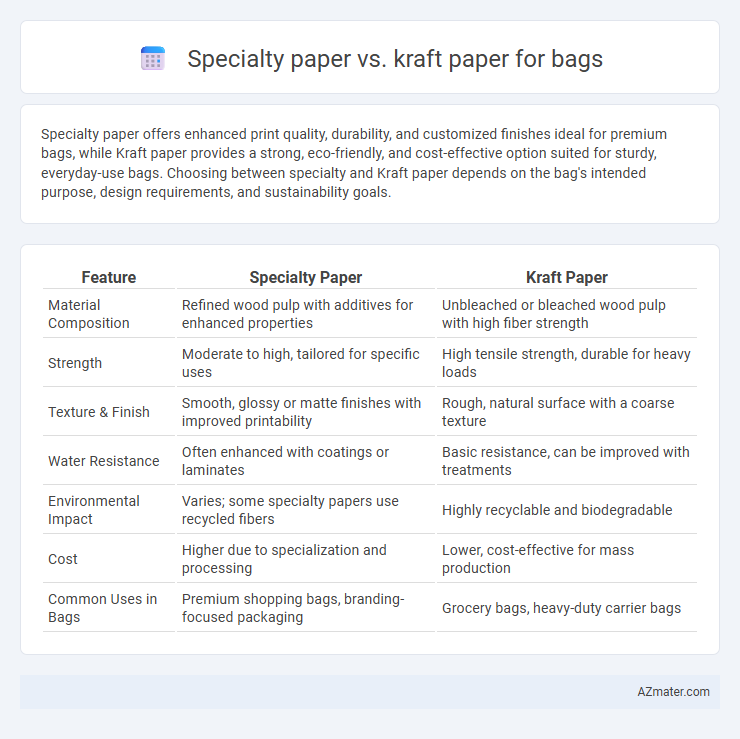Specialty paper offers enhanced print quality, durability, and customized finishes ideal for premium bags, while Kraft paper provides a strong, eco-friendly, and cost-effective option suited for sturdy, everyday-use bags. Choosing between specialty and Kraft paper depends on the bag's intended purpose, design requirements, and sustainability goals.
Table of Comparison
| Feature | Specialty Paper | Kraft Paper |
|---|---|---|
| Material Composition | Refined wood pulp with additives for enhanced properties | Unbleached or bleached wood pulp with high fiber strength |
| Strength | Moderate to high, tailored for specific uses | High tensile strength, durable for heavy loads |
| Texture & Finish | Smooth, glossy or matte finishes with improved printability | Rough, natural surface with a coarse texture |
| Water Resistance | Often enhanced with coatings or laminates | Basic resistance, can be improved with treatments |
| Environmental Impact | Varies; some specialty papers use recycled fibers | Highly recyclable and biodegradable |
| Cost | Higher due to specialization and processing | Lower, cost-effective for mass production |
| Common Uses in Bags | Premium shopping bags, branding-focused packaging | Grocery bags, heavy-duty carrier bags |
Introduction to Specialty Paper and Kraft Paper
Specialty paper for bags is engineered for specific performance qualities such as enhanced strength, printability, and moisture resistance, making it ideal for premium or customized packaging solutions. Kraft paper, derived from the kraft pulping process, is renowned for its durability, natural brown color, and eco-friendly properties, widely used in sturdy, cost-effective bag manufacturing. Both materials offer distinct advantages depending on the required aesthetic, strength, and environmental considerations in bag production.
Key Differences Between Specialty Paper and Kraft Paper
Specialty paper offers tailored properties such as enhanced printability, texture, and finish, making it ideal for custom bags requiring visual appeal and branding precision. Kraft paper, known for its strength, durability, and eco-friendliness, is commonly used for bags that need to withstand heavy loads and environmental exposure. Key differences include the production process, with specialty paper often involving chemical treatments and coatings, while Kraft paper is produced using a mechanical or chemical pulp process that preserves long fibers for toughness.
Strength and Durability Comparison
Specialty paper for bags offers enhanced strength and durability through advanced fiber blends and coatings, making it resistant to tearing and moisture. Kraft paper, known for its natural brown color and high tensile strength, provides robust durability ideal for heavy-duty bag applications. When comparing both, specialty paper generally delivers superior tear resistance and water repellency, while kraft paper excels in eco-friendliness and cost-effectiveness without compromising essential strength.
Appearance and Customization Options
Specialty paper offers a smooth, high-quality surface ideal for vibrant printing and detailed designs, enhancing the visual appeal of bags. Kraft paper features a natural, rustic texture with earth-toned colors, providing an organic look popular for eco-friendly packaging. Customization options for specialty paper include glossy, matte, or textured finishes and a wide color palette, while kraft paper customization is often limited to natural shades with options for embossing, debossing, or simple printing.
Eco-Friendliness and Sustainability
Specialty paper for bags often incorporates recycled fibers and biodegradable coatings, enhancing eco-friendliness by reducing waste and supporting sustainable forestry practices. Kraft paper, made from natural wood pulp through a chemical process, is highly valued for its strength, recyclability, and compostability, making it a leading choice in sustainable packaging. Both materials contribute to reducing environmental impact, but Kraft paper's minimal processing and renewability typically provide a stronger sustainability profile for eco-conscious bag manufacturing.
Cost Analysis: Specialty Paper vs Kraft Paper
Specialty paper typically incurs higher costs due to its enhanced properties like printability, texture, and coating, making it ideal for premium or branded bags but less economical for bulk production. Kraft paper, known for its strength and durability, offers a more cost-effective solution driven by its simple manufacturing process and widespread availability. Businesses aiming for budget-friendly packaging often prefer kraft paper, while those requiring high-end aesthetics may justify the additional expense of specialty paper.
Printing and Branding Capabilities
Specialty paper offers superior printing and branding capabilities for bags due to its smooth surface and high-quality finish, enhancing color vibrancy and detail precision. Kraft paper, while eco-friendly and sturdy, provides a more rustic look with limited printing sharpness and color range, often requiring specialized inks for optimal results. Brands aiming for premium visuals typically prefer specialty paper, whereas kraft paper suits rustic or natural branding themes with moderate printing demands.
Ideal Applications for Each Paper Type
Specialty paper is ideal for high-end retail, gift packaging, and promotional bags due to its smooth texture and ability to hold vibrant prints and finishes. Kraft paper, known for its durability and eco-friendliness, is best suited for grocery bags, shipping sacks, and heavy-duty packaging requiring strength and tear resistance. Choosing the right paper depends on whether the priority is aesthetics and print quality or structural integrity and sustainability.
Consumer Perceptions and Market Trends
Specialty paper offers enhanced print quality and unique textures that appeal to eco-conscious consumers seeking premium and sustainable packaging options, driving increased demand in niche markets. Kraft paper, known for its durability and natural appearance, remains popular for cost-effective, recyclable bags favored by environmentally aware shoppers prioritizing functionality and simplicity. Market trends indicate a growing preference for biodegradable materials, with specialty paper gaining traction in luxury retail segments while kraft paper dominates everyday consumer goods packaging.
Choosing the Right Paper for Your Bag Needs
Specialty paper offers enhanced print quality, durability, and custom finishes, making it ideal for luxury or branded bags requiring a premium appearance. Kraft paper provides superior strength, eco-friendliness, and cost-effectiveness, perfect for heavy-duty or recyclable shopping bags. Selecting the right paper depends on balancing factors like bag function, brand image, environmental impact, and budget.

Infographic: Specialty paper vs Kraft paper for Bag
 azmater.com
azmater.com